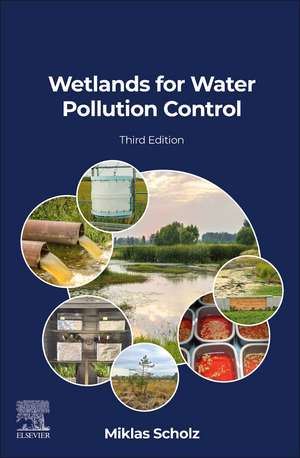Wetlands for Water Pollution Control
Autor Miklas Scholzen Limba Engleză Paperback – 10 noi 2023
Users will find the latest research in wastewater treatment and runoff control presented in a manner that is ideal for academics, senior consultants, final year and postgraduate students, and graduate engineers, respectively.
- Includes twelve new chapters with a broad overview of water and environmental engineering aspects relevant for the drainage and treatment of stormwater and wastewater
- Contains case study topics covering wetlands, including natural wetlands and constructed treatment wetlands, sustainable water management, including sustainable drainage systems, and specific applications such as wetlands treating hydrocarbon, greywater, and piggery dye wastewater
- Captures the latest findings in wastewater treatment, with chapters focusing on practical applications and field studies
Preț: 943.57 lei
Preț vechi: 1227.05 lei
-23% Nou
Puncte Express: 1415
Preț estimativ în valută:
180.55€ • 189.02$ • 149.39£
180.55€ • 189.02$ • 149.39£
Carte tipărită la comandă
Livrare economică 31 martie-14 aprilie
Preluare comenzi: 021 569.72.76
Specificații
ISBN-13: 9780443138386
ISBN-10: 0443138389
Pagini: 1018
Dimensiuni: 152 x 229 mm
Greutate: 1.33 kg
Ediția:3
Editura: ELSEVIER SCIENCE
ISBN-10: 0443138389
Pagini: 1018
Dimensiuni: 152 x 229 mm
Greutate: 1.33 kg
Ediția:3
Editura: ELSEVIER SCIENCE
Cuprins
1. Water quality standards
2. Water treatment
3. Sewage treatment
4. Stream pollution and effluent standards
5. Preliminary treatment
6. Primary treatment
7. Coagulation and flocculation
8. Sludge blanket clarifiers
9. Flotation systems
10. Slow filtration
11. Rapid filtration
12. Biological treatment
13. Biological filtration
14. Rotating biological contactors
15. Activated sludge processes
16. Iron and manganese removal
17. Water softening
18. Water microbiology
19. Disinfection
20. Constructed wetlands
21. Sludge treatment and disposal
22. Wetlands treating contaminated stream water
23. Wetland systems to control roof runoff
24. Wetlands treating road runoff
25. Combined wetland and below-ground detention systems
26. Modeling of constructed wetland performance
27. Infiltration wetland systems
28. Retrofitting of sustainable drainage systems in the presence of vegetation
29. Tree species for use in urban areas supporting sustainable drainage
30. Expert tool based on ecosystem service variables for retrofitting of wetland systems
31. Sustainable drainage system model
32. Natural wetlands treating diffuse pollution
33. Impact of climate change on wetland ecosystems
34. Future climate scenario impacts on peatland and constructed wetland water quality under water level management
35. Integrated constructed wetlands for pollution control
36. Infiltration and contaminant migration beneath integrated constructed wetlands
37. Seasonal assessment of vertical-flow wetlands treating domestic wastewater
38. Comparison of domestic wastewater treatment by mature vertical-flow constructed wetlands and ponds
39. Recycling of domestic wastewater treated by vertical-flow wetlands for irrigation
40. Microbial contamination of Capsicum annuum irrigated with recycled domestic wastewater treated by wetlands
41. Contamination of soil and Capsicum annuum irrigated with recycled domestic wastewater
42. Modeling of vertical subsurface-flow constructed wetlands treating municipal wastewater in hot and dry climate
43. Remediation of graywater in floating treatment wetlands
44. Graywater treatment with pelletized mine watersludge
45. Industrial water treatment within a planted wetland and subsequent effluent reuse to grow vegetables
46. Piggery wastewater treatment with integrated constructed wetlands
47. Dye wastewater treatment by vertical-flow wetlands
48. Ponds covered with Lemna minor treating dyes
49. Wetland systems as part of the sustainable flood retention basin concept
50. Classification of sustainable flood retention basins
51. Water-sensitive urban development for climate change adaptation
